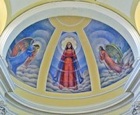

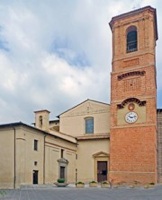
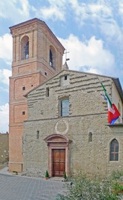
According to tradition, this church is built on the site of the house where St Crispoltus performed his first miracle. This ancient church was enlarged and re-consecrated by Bishop Guido II of Assisi, Bishop Giovanni of Perugia and Bishop Egidio of Foligno in 1225, an event that is commemorated by an inscription in the sacristy. It became the most important church in the town, and was administered by a community of canons.
In 1265, the Benedictines of the Abbazia di San Crispolto moved the relics of St Crispoltus to a new site within the city walls that belonged to canons of Santa Maria Maggiore, where they built the church of San Crispolto. The canons initially objected, but Cardinal Giacomo Savelli (the future Pope Honorius IV) was able to negotiate a compromise, whereby the right of Santa Maria Maggiore as the parish church of Bettona were preserved and the donations received on the feast of St Crispoltus were shared between the two churches.
The adjacent collegiata was rebuilt in 1797. The church on its current neo-Classical appearance following its re-modeling in 1803-16 by Giovanni Cerrini.
[A chapel - where ?? - that survives from the 13th century structure was dedicated to Saint Rita of Cascia in 1934].
Interior
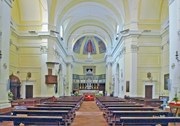
Ciborium (1590)
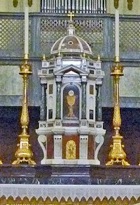
Virgin and Angels (1939)
Crucifix (14th century)
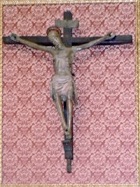
Mystical Marriage of St Catherine (ca. 1600)

SS Crispoltus and Giles (17th century)

Crucifixion with saints (17th century)
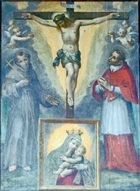
Madonna and Child with saints (1615)
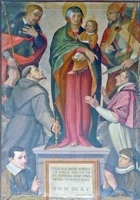
Madonna of the Rosary (16th century)
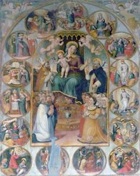
St Antony Abbot (16th century)
St Joseph (1667)
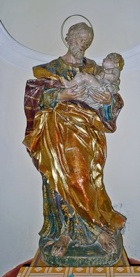
Art from the Church
The following are now in the Pinacoteca Civica.
Assumption of the Virgin (early 15th century)
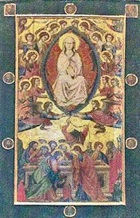
Gonfalon (15th century)
This double-sided processional banner was documented in 1863, when it was in the house of the archpriest. It was the subject of litigation between the archpriest Morbidello and the Commune in 1902, but eventually passed to the latter. It was restored in 1927-8.
The banner is attributed to the workshop of Nicolò di Liberatore, l' Alunno. It depicts:
-
✴the Crucifixion with the Virgin and St John the Evangelist on one side; and
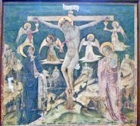
-
✴the Pietà with the Virgin and St John the Evangelist on the other.
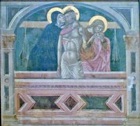
Gonfalone di Sant’ Anna (15th century)
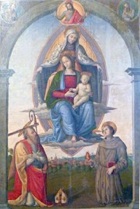
-
✴St Crispoltus on the left; and
-
✴Blessed Peter Negles on the right.
Lost Inscription
Anonymous from Bettona (4th century AD)
This fragmentary inscription (CIL XI 5170; EDR 125668) was on a stone that was re-used in the facade of the church:This fragmentary inscription (CIL XI 5170) was on a stone that was re-used in the facade of the church: it was detached in 1797 and subsequently lost. A surviving transcription indicates that only a fragment from the centre of the original inscription had survived:
...]a Tuscia suam [...
...]avit neq(u)idem ad aliquam q(u)aes[...
...]it ob quem liberalitatem suam etiam [[...
...]in urbe sacra administrans et pro amore civico filios ei[us...
...Di]scolium et Apronianum tabulis aere inciso[s ...
...] plebis civica patronos cooptarunt ex quibus [...
...prae]tore Aetruriae XV p(o)p(ulorum) dedit Discolium et Apronia[num ...
...]m Aetruriae ludos aedidit paradoxis et urbe et div[..
...]os per decen dies aepula ordinibus propîna[t] et ce[nas ...
...]nis diebus dedit et civitatibus ex sen[atus ...
...]otidem et annonas et cum[...
...]us [---]axis[...
The fact that one of the sons of the subject was called Apronianus suggests that he came from the same family as Lucius Turcius Apronianus, who was Corrector of the Province of Tuscia et Umbria in 342 AD. The inscription records that, because of his love, his sons, Discolius and Apronianus had become patrons of a city, presumably Vettona. He had held games in Etruria (‘Aetruriae ludos aedidit’), presumably as Praetor Etruriae XV Populorum.
The inscription is discussed in the context of the Praetores Etruriae in the page on the Revived Etruscan Federation.



